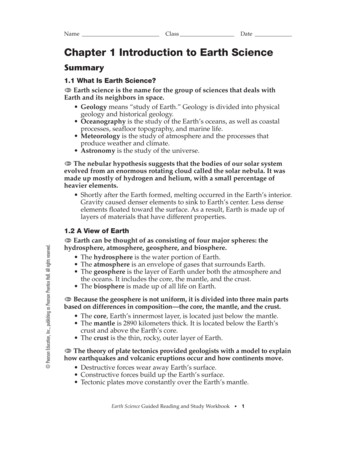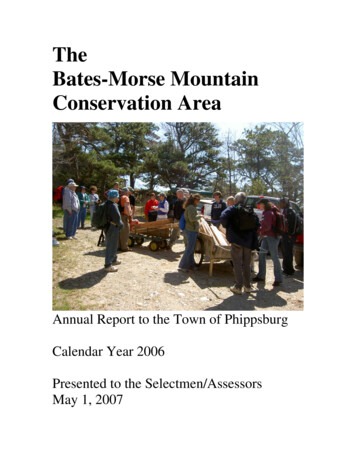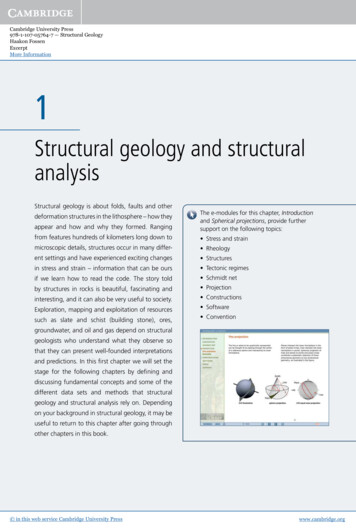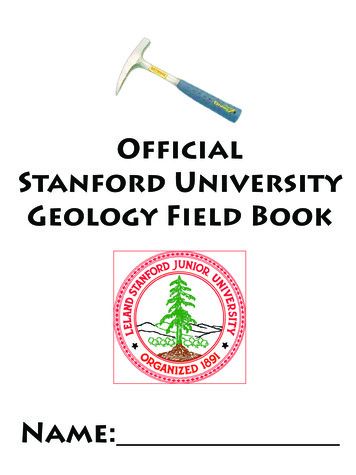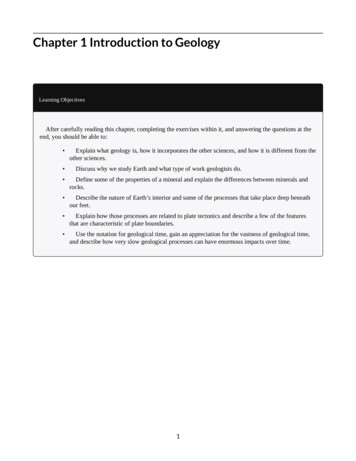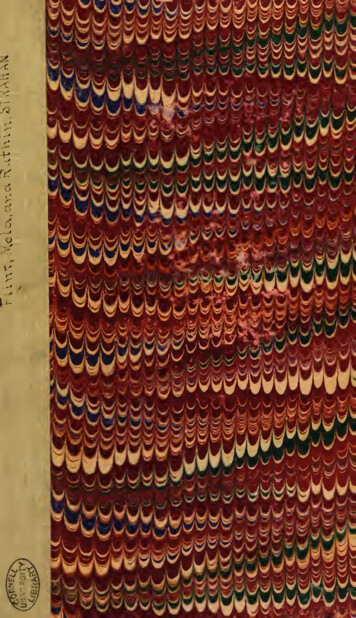
Transcription
» .' I ?m&miVVy :wo«afflynu A mpwm\co'aW Wi
SOS mutll Utttomtg ff itr«gBOUGHT WITH THE INCOMEFROM THESAGEENDOWMENT FUNDTHE GIFT OFflcnrg111.Sage1891ENGINEERING LIBRARYA-.//JM/./4
Cornell University LibraryQE262.F6S89 1890The geology of the neighbourhoods of Fli3 1924 004 553 446
Cornell UniversityLibraryTheoriginal of thisbookis inthe Cornell University Library.There are no known copyrightrestrictions inthe United States on the use of 53446
;MEMOIRS OP THE GEOLOGICAL SURVEY.ENGLAND AND WALES.THE GEOLOGYOF THE NEIGHBOURHOODS OFAND RUTHIN.FLINT, MOLD,(EXPLANATION OF QUARTER-SHEET 79S.E.)BYAUBREY STBAHAN,(with parts by 0. E.PUBLISHED BT ORDER OFTHTDDE RANCE,M.A., F.G.S.,Assoc. Inst. C.E., F.G.S.)LORDS C0MM1SSI0NEKS OF HEE MAJESTY'S TBEASUJiT.LONDON:raiN'I'EDFOR HER MAJESTY'S STATIONERY OFFICE,BY EYRE AND SPOTTISWOODE,FB1KTEBS TO THE QUEEN'S MOST EXCELLENT MAJESTT.And to be purchased, either directly or through any Bookseller, fromEYRE and SPOTTISWOODE, East Habdiho Street, Fleet Street, B.C.ADAM ASD CHARLES BLACK, 6, Nobth Bridge, EDiirBt/B«Hi orjHODGES, FIGGIS,ftCo., 104,Graston Stbeet, DttbIis.1890.Price Four Shillings and Sixpence.
Missing Page
MEMOIRS OF THE GEOLOGICAL SURVEY. ENGLAND AND WALES.vvtIMt-»THE GEOLOGYOF THE NEIGHBOURHOODS OFAND RUTHIN.FLINT, MOLD,(EXPLANATION OF QUARTER-SHEET 79S.E.)BYAUBREY STRAHAN, MA.,(with parts by C. E.PUBLISHED BY01! DEEDE RANCE,RG.S.,Assoc. Inst. C.E., F.G.S.)OF THE LORDS COMMISSIONERS OF HEB MAJESTY'S TKEASUttt,LONDON:TRINTEI)FOR HEK MAJESTY'S STATIONERY OFFICE,BY EYBE AND SPOTTISWOODB,PB1NTEBS TO THE QUEEN'S MOST EXCELLENT MAJESTY.And to be purchased, either directlyor throughany Bookseller, fromEYRE and SPOTTISWOODB, Bast Habding Steebt, Fleet Stbeet, B.C.;ADAM AND OHAELES BLACK, 6, Nobth Bmdgb, Edinbubgh; orHODGES, FIGGIS, & Co,104,Gbaeton Stbeet, Dublin.1890.Price Four Shillings and Sixpence,ior
PREFACE.TnEedition of the Quarter-sheet of thefirstSurvey (79 S.E.) describedlogicalMapsthe presentinpublished in 1850, and was revised up to1855.of the GeoMemoir wasThe westernmapped by Mr. W. T. Aveline, the CoalMeasures by Mr. D. H. Williams, and the New Red Sandstoneby Professor E. Hull, while the lodes were inserted by Sir W. W.portion was principallyTheSmyth.made onthe six-inch scale,and otherMemoir werecollectedDe Ranee and A.Strahan,materials for the presentduring a re-survey by Messrs. 0. E.whensuperficial depositsthe boundaries of the Glacialwere traced for thetime.TheNew RedSand-firsteastern part of the Quarter-sheet, comprising thestone and the Flintshire Coal-field (exclusive of thedistrict),was re-surveyed by Mr.map by Mr.DelieRanee, the remainder of theQuarter-sheet 79 S.E. (Old Series) coversStrahan.nearly the same area as Sheet 108the latterLeeswood(NewSeries).Thelimits ofabout half-a-mile further south and further westthan those of the earlier map.Thearea represented includes portions of the Vale of Clwyd,the Estuary of the Dee, and the intervening high ground composedof Silurianand Lower Carboniferous Rocks.Considerable changes have beenVale of Clwyd.Themadeboniferous rocks, and to pass on to theshownto be affectedin themapping of theTrias, formerly believed to overlap the Car-by a greatfault,WenlockShale,isnowwhich throws down bothCarboniferous and Triassic strata along the western flanks of theSilurian range.ofnewer rocksdue—UTothis dislocationin theSilurianthe existence of the outlierarea of NorthWalesismainlya structure that forms a striking analogy to that of the60799.500.— 9/90.Wt. 15530.B.&S.a 2
Vale of Eden.In both these tracts thefaultcameinto exist-ence principally in pre-Triassic times, but was increased after thered sandstone had been deposited.Thepre-Triassic movements,of which this fault forms part, led to the second greatconformability observable in this district,viz.,un-that between theCarboniferous and Triassic formations.The Carboniferous Limestone,Millstone Grit, andLower Coal-Measures show considerable horizontal changes within thelimitsIn the northern part they are fine-grained intexture, while southwards the whole series expands, at the sameof this map.time that clays pass into sands, andsandsintopebblygrits.Similarly the black limestone of the north of Flintshire mergessouthwards into a thick series of alternating sandy limestonesand pebbly calcareous sandstones, while the Chert Beds are replaced by massive pebblygrits.Lastly, theLower Coal-Measuresof the south contain thick sandstones, scarcely distinguishablefrom Millstone Grit, which are almost unrepresented in the north,[n the Coal-Measures, too,seams whichiswe donot find the persistence in thenoticeable in other coal-fields furthersuch an old mountain-centre as that ofremoved fromThe seamsNorth Wales.vary rapidly in thickness, and the lowest seams of the northerndistricthave remained undiscovered,Thesouthern area.they are present, in thesmall coal-field of Leeswood acquired im-portance from the discovery indistillation of paraffinifoil.itof the Cannel Coal, used for theThe workingsin this coal encountereda river-channel of Carboniferous age, the course of which, so faras proved, hasbeen laid down in PlateI.Traced towards the west, the changes becomeThestrata lying nextshow nostillmore marked.above the limestone in the Vale of Clwydsimilarity to the Flintshire Millstone Grit, but so close aresemblance to theLower Coal-Measuresas to indicate that theMillstone Giit thins out along the Flintshire outcroption supportedby the actual overlapfor a short distance nearTheDrift,New Eedof the grit—a supposi-by Coal-MeasuresEhydymwyn.Sandstone, for the most part,but the unconformable junction ofthisliesburied underrock and theLowerCarboniferous strata can be observed in the Vale of Clwyd, andin thewell-known section of CuckooHill, nearHope.
—TheGlacial Deposits include two drifts of distinct origin,that which travelled from the north over LancashireTheand that which came from Welsh sources in the south-west.two meet along aviz.,and Cheshire,which partly follows the Welsh border,linebut runs across the gentlerof the Flintshire Coal-field.hillsSeveral examples of striated rock-surfaces have been recorded, inof which theallalsopoint in the direction in which the Driftstriaethem hasassociated withtravelled.Vast numbers of bouldershave been brought from the Snowdon and Arenig rangesand dropped upon the western flanks and the tops of the Silurianand Carboniferous ranges.24feet long,300 tonsandThein weight.Oneof the largest of these erraticsvisible portionitscan scarcelyfact that the Driftfallisshort ofwas borne acrossthe outcrops of the various rocks, and nearly at right anglesto them, has led to evendeposit thanTheismorevariability in the nature of theusually observed.history of the Rivervalley of this rivershownisDeeisgiven in some detail, and theto coincide with a pre-Glacial estuary(or depression), filled with Glacial Drift.river,however, follows a post-GlacialEccleston,and Chester, the pre-Glacialchoked withDrift,Chapter XIII.mines.Thevalley,throughnowcompletelydevoted to a detailed account of the lead-veins are separable intoThetwosets of different direction,principal lead-bearing zones in theCarboniferous Rocks, and the various forms of " vein,""flat," inTheMemoirMr.has been edited and mainly written byDeRanee's contributions are as follows:account of the Lower Coal-Measures of Northop and Hawar-den, on pp. 66, 67, 71Coal-Measures;Chapter VII., pp. 72-99, on the Middle;and notes on the Drift of133,. 135, 139-144.inLower" pipe," orwhich the ore occurs, are indicated.presentMr. Strahan.AnHolt,running past Dodleston and Rossett.iscontents, and age.The upper part of thecourseThe determinationwas commenced bycollectedby him.of the fossils collected during the re-surveyMr. R.Messrs. Sharman and Newton,correction of the synonymy.also,on pp. 132,Several also of the Colliery Sections, givenAppendix L, wereG. H. Mortonhis area,whoEtheridge, butwhoThecompletedbyare responsible also for thelistswere submittedkindly noted some additions.toMr.
VIA generalshireisgeological bibliography for Flintshirepublished in theMemoiradjoining Rhyl, Abergele, andMemoir formsdescriptiveand Denbighof The CoastsColwyn (1885), of which the presentin part a continuation.ARCH. GEIKIE,Director-General.Geological Survey Office,28,JermynStreet,London,19th February 1890.
——TABLE OF CONTENTS.PagePbeface, TRODUCTION AND TABLE OF STRATAUPPER SILURIAN ROCKS Wenlook Shale CARBONIFEROUS ROCKS THE VALE OF CLWYD.-.-7--(1.)The Basement Beds(2.)The Carboniferous Limestone,-9Coal-MeasuresIV.Millstone Grit, and-—careous Sandstone SeriesHope Mountain-CARBONIFEROUS ROCKS,The Millstone Grit:CHAP.VI.VII.Trelogan and Holywell(2.)RhydymwyntoThe Calcoed(2.)From Holywell(8.)Hawarden and Tryddyn(8.)toHopeCHAP.VIII.RhydymwynandThe ilsabove areas(5.)and the Cal-cont.The Northern areaThe Eastern area The Fireclay Series(4.) Faults2024:The Middle Coal-Measures(2.).OutlierCARBONIFEROUS ROCKS,(1.).cont.(1.)--cont.,1718-HopeCARBONIFEROUS ROCKS,Introduction-cont.(1.)to-—The Lower Coal-MeasuresCHAP.10;:V.-CARBONIFEROUS ROCKS, cont. EAST OF THE MOELFAMMAU RANGE.Carboniferous Limestone(1.) The Lower Brown Limestone(2.) The Grey and White Limestones(3.) The Black Limestone(4.) The Grey and White Limestones,CHAP.4::Structure of the ValeCHAP.1-.---of abandoned mines in the-Coal-field----9098CARBONIFEROUS ROCKS: MIDDLE COAL-MEASURES, cont.The Leeswood Coal-held —:Structure and faultsCHAP.IX.The Main CoalThe Cannel Coal-Other coal seams----X.-----100104105111THE NEW RED SANDSTONE, OR TRIAS (BUNTER).(1.) Cheshire and Flintshire(2.) The Vale of ClwydCHAP.---.--SANDS AND FHiECLAYS IN THE CARBONIFEROUSLIMESTONE113116119
V1UPageCHAP.XI.SUPERFICIAL DEPOSITS.Introduction--Boulder Clay and Sand and Gravel (Glacial)Introduction-The Vale of Clwyd(2.)(3.)(4.)The Valley of the Chwiler (or Wheeler)The upper Valley of the AlynThe lower Valley of the Alyn(5,)Halkin MountainTheCoal-field---.Triassic areaGlacial StrideXII.--and the-BouldersCHAP.SUPERFICIAL 3.)149150151151:159—Holywell:The Old Holloway, and adjoining veinsThe Miliar, and adjoining veins Halkin Mountain163168172From Bryn-gwiog to Rhydymwyn From Rhydymwyn to Gwern-y-mynydd(5.) From Gwern-y-mynydd to Maes-y-safn(6.) From Maes-y-safn to near LlanarmonHaematite, Copper, and Manganese Ores181185(4.)APPENDIX(2.)191194197I.Collieries and Boreholes in the Flintshire Coal-fieldBorings in the Estuary of the Dee-Economic Geology--APPENDIX-.(3.) Wells near the Welsh Border(4.) St. Winifred's Well, Holywell(5.)144146METALLIFEROUS MINES.Lead and Zinc Mines(i.)126129129131132136139cont.River TeebacesCalcareous TufaPeat and AlluviumThe Estuary op the DebCHAP.126--199215221222223II.Tables of Fossils.Tahle I.„ II.Wenlock ShaleCarboniferous226227
5IXLIST OF ILLUSTEATIONS.Fig.1.2.Section across the Vale of Clwyd Fault, showing the displacement Unconformable junction of the Trias and Carboniferous Kocks near8„12„3.PUs-dr&wSection from Holywell„4.Section„5.„6.Section across Moel FfagnalltSection along the Vein and Adit-level from Bryn-bellan to Pant-y-„7.Comparative views of the Calcareous Sandstone Series of Hendre and„8.acrossacross Pen-y-ball Commonaud the .----.Gwern-y-mynydd-2830--35.,,10.Section across the Lower Carboniferous Rocks near LlanferresSection across the northern end of Hope Mountain Erookhill Brickworks„11.Trap Brickworks„12.Section across„13.„14.„„15.16.Brook-section at Cuckoo Hill, showing the unconformable junctionof the New Bed Sandstone and Lower Coal-MeasuresCoast-section at Burton Point, showing the junction of the PebbleBeds and Lower Mottled SandstoneOld Fire-clay Pit, Foel-ddu, near Rhes-y-caeMap of South Lancashire, Cheshire, and the Welsh Border, showing„17.positions and directions ofDiagram showing directions„18.Diagram showing19.20.21.SectionSectionPlan ofSectionSectionSection„9.Cheshire, .„„22.23.24.„„„Plate„I.II.Hawarden OldColliery,Mare HayU607U9.-.--.------.------3840458889961141 1120128anddirections of Stria? on the Welsh Border showing the distribution of Ore in the Deep Level Mineshowing the distribution of Ore in the Rhosesmor Minethe workings in the North Hendre Flatshowing the distribution of Ore in the Bryn-celyn Veinshowing the distribution of Ore in the Pant-y-mwyn Veinshowing the distribution of Ore in the Maes-y-safn Vein-145145180181183186187194112Reclamations in the Estuary of theshowing the distribution of Orey-mynydd Mines -III. Section.Glacial Striaeof Stria? in South LancashireMap of the Leeswood Coal-fieldMaps showing Alterations andDee„--in the-158Cat Hole and Gwern-189
—THE GEOLOGYOP THE NEIGHBOURHOODS OFFLINT, MOLD,AND RUTHIN.CHAPTER I.INTRODUCTIONandTABLEofSTRATA.In this Quarter-sheet is found the continuation of the rangesof the Silurian Rocks, Carboniferous Limestone, and MillstoneGrit, which run down to the sea near Prestatyn and Rhyl, andwhich have been described in the Memoir on that neighbourhood(Quarter-sheet 79 N.W.).The principal hills in the presentarea are as follows:
;INTRODUCTION. *Carboniferous Rocks andNew RedSandstone; on their eastliethe gentler hills of the Coal-Measures of the Flintshire Coal-fieldwhile the eastern side of the map is occupied by a portion of theNew Red Sandstone of the Cheshire plains, and by the interveningestuary of the Dee.The area is drained by the Clwyd, the Dee, and its tributarythe Alyn. The Clwyd, rising in the Silurian hills of centralDenbighshire, enters the Vale of Clwyd by a steep-sided breach inthe Carboniferous Limestone, near Llanfair, and flows thence, ina channel excavated almost wholly in Drift, to the sea near Rhyl.The Alyn, risingand draining the- Vale of Llanarmon,« whichseparates the Silurian from the Carboniferous Limestone hills,flows north as far as Cilcain, but breaks abruptly through thelimestone-escarpment near thjfcplaggj; and. turns to the south-eastacross the Coal-Measures by Mold and Hope.On emergingfrom the deep gorge by which it traverses the limestone, the Alynfalls into an old line of valley, which is prolonged right throughthe Moel Fammau rangei into thV.Vafe of Clwyd, by way ofNannercb, Caerwys, and B odfarJL This old valley it followssouthwards, receiving merely a small tributary from the northernextension named above, whichr. is. drained by, the River Chwiler(or Wheeler), a tributary of the Clwyd.mThe watershed between the Alyn and the Clwyd follows theThencesummit-level of the Silurian hills as far as Moel Arthur.it turns north-eastwards to Moel Plas Yw, and follows the road byBryn-y-groes to the south side of Penbedw Park, where it crossesthe valley above mentioned. Its height above the sea in thisvalley is 52,0 feet, but its exact position is so ill-defined that itseems to be little more than chance whether the stream descending from the south side of Moel Arthur turns to the north intothe Chwiler, or to the east into the Alyu.The water enters asubterranean course at Siamber Wen, but reissues at Tardd-ydwr, at 600 yards distance, and flows thence to the Alyn; butthe open-air course, which is still used in heavy floods, runs northDuring the flood ofof this line and enters the Clwyd system.August 1879, both channels were used, so that the water of thestream reached the sea partly by way of the Dee, partly by wayof the Clwyd.From this point the watershed runs northeastwards to Moel Ffagnallt and the chert-hills above PentreH*lkin.The north-easterncorner of the map is occupied by the Triassieof part of the peninsula of Wirral, of which about threesquare miles, around Great Sutton and Capenhurst, drain intothe basin of the Mersey.The small streams flowing over thewestern part of the peninsula make their way into the estuary ofthe Dee, which opens out into a trumpet-shaped area of considerable size in the map to the north.The contents and history ofthis estuary are described in Chapter XII.hills
*TABLE OF STBATA.3The various rocks and Drift-deposits distinguished bytwo editions of this map are as followsthe:(Recent and post- JGlacial-Glacial-Trias,or-.colour onAlluvium.'Peat-.- River Terraces (Gravel).L Calcareous Tufa.on ier V{ l Sand and Gravel.,,,New P Upper MottledRed Sandstone(Bunter)— -ISandstone.Pebble Beds.Lower Mottled Sandstone.TMiddle Silurian„-( Millstone Grit.-{ B yweUShalaj.Chert Beds and sandstones./ J?**Wenlock Shale withP "occasional sandstone.* This Quarter-sheet is published in- two editions on the one-inch scale, the onefor Superficial Geology, showing all (he formations named in the table, in the otherall the Glacial Deposits 'being omitted to give a fuller view of the range of theunderlying rocks. Manuscript copies of the six-inch maps have been deposited inthe Geological Survey Office for reference, or for copying if desired.A 2
UPPER SILUHIAN BOCKS.CHAPTERII.UPPER SILURIAN ROOKS.Wenlock" Shale.The whole of the Moel Fammau raDge is composed of rocksbelonging to the Wenlock Shale, and consisting principally ofroughly cleaved shales with fine-grained sandstones occasionallyThe direction of the cleavage is almost constantinterstratified.through the whole length of the range; in Moel-y-parc itaverages E. 35 S., bending on the south and east sides of Pen-yNear Pen-machno itcloddfau to about E. 30 S. and E. 25 S.ranges E; 15'— 20 S., and on Moel Fammau E. 10 — 16 S.(except locally on the north side of Moel-y-Gaer, where it pointstwo or three places E. 10 16 N., perhaps owing to faults).South of Foel Fenlli it resumes the direction E. 20 S., or, south35 S.The cleavage therefore crossesof Moel Gy w, of E. 20 —in—the range obliquely.Eegarding the district as a whole, we might consider the strikeof the rocks to be nearly parallel to the direction of the range,and to be crossed obliquely by the cleavage; but locally thestrike and cleavage are generally parallel, for the strata have beenbent into a number of small synclinal and anticlinal folds, theThis coinaxes of which run strictly parallel to the cleavage,cidence of direction leads to the supposition that the folds andcleavage were contemporaneously formed, as a result of compression by forces acting from the north-north-east, and southsouth-west and, as we have elsewhere shown, at a time when theWenlock Shale was deeply buried under newer Silurian Rocks(Ludlow Beds, &c.)* At the same time, upheaval, due to the sameforce?, led to the denudation of the newer Silurian strata and tothe preparation of the floor of old rocks, over which the CarboniAt a comparatively lateferous group was subsequently spread.date the district was traversed by faults and gentler folds, bywhich the Carboniferous rocks, and the Trias also in part,' wereaffected, and by which such striking features in the configurationof the country as the Vale of Clwyd and the Moel Fammaurange were produced. The approximate parallelism of the trendof this range to the strike of the strata composing it is thereforeaccidental.The description of the Wenlock Shale will be convenientlytaken from north to south.On the north side of the Wheelervalley flags are exposed in the deep strike-ravine of Coed-cochion,*The Geology of the Coasts adjoining Rhyl, &c. (Mem. Geol. Survey. ExplanaDenudations of North Wales, Proc.tion of Quarter-sheet 79 N.W.), 1885. See alsoChester Soc. Nat. Set. No. 3, p. 38, 188S.
WENLOCK SHALE,5the dip ranging from 55 to 90 to the south-west ; the rockappears again near Maes-mynan, but is concealed by Drift elsewhere fen this side of the valley. On the south side, howeverthe Drift-less slopes of Moel-y-parc rise abruptly from the river.quarry near Caerwys, on the side of the road to Bryn-yreifhin, exp es massive and slaty mudstones, which have beenused for mixing (after being ground up) with a pure limestone inthe manufacture of cement.The greater part of the hill iscomposed of pale shales, with sandy bands, and occasional thinbands of sandstone or fine grit, one of which on the north-westside of the hill contains some small and obscure fossils.Thestrata are bent into many small folds, and in more than oneinstance small cirque-like hollows have been excavated along theanticlines, as, for instance, on the south side of the valley leadingup from the Grove. The hill also forms the resting place of anumber of erratic boulders of felspathic rock from the Bala Beds,Aas hereafter mentioned (p. 147).On crossing the neck that connects Moel-y-parc with Pen-ycloddiau we find a band of grit and of interstratified shales and—60 to the south-west,thin sandstones, with a steady dip of 30 the grit containing obscure impressions of minute fossils (chieflysmall Orthis).These beds, which may be traced through thetop of Pen-y-cloddiau and for about 300 yards down itssouthern slopes, show well the different effects of pressure onsandy and clayey beds the thin sandstone-bands being crinkledin a number of minute but regular puckers, while the interveningseams of shale are cleaved.On the south-eastern side of the hill also, in the road toNannerch, some thin beds, of grit, one of which is slightlycalcareous, are imbedded in fine well-cleaved shale.But theeastern slopes of the hills as a rule show remarkably fewexposures.In the few old quarries that occur the dip generallyTaries between north-west and south-west, the rock being a moreor less sandy shalein one case a quarry 400 yards north ofshows a nodular structure developed in the shale alongPlasthe cleavage-planes, independently of the bedding.The south-westerly dip which prevails through Pen-y-cloddiaucontinues (with local exceptions) through Moel Arthur and MoeiXJys-y-coed.From the former hill a hard micaceous sandstonemay; be traced southwards past a synclinal fold which runsparallel to the cleavage through Moel Llys-y-coed, and .thenceeastwards as far as the Drift-filled valley at Plas-newydd, itsOn the south sideaxis running between this farm and Lletty.of this syncline a corresponding anticline runs a little north ofPen Machno. Three or four hundred yards south-west of PenMachno some shales, lying immediately above the sandstone which;;Yw.runs through Moel Arthur, have been tried for slates.From the Bwlch-y-Cilcain southwards some thin-bedded sandstones and shales may be traced for a considerable distancethrough several of the small folds connected with the cleavage.Nearly in the axis of the anticline, which causes the sharp
UPPER SII/UKTAN ROCKS.6westerly bend in the beds north of the fault indicated on the map,there are some trials in a quartz-vein, bearing about E. 37 S.,and said to contain specks of copper. There, as elsewnere inthese rocks, vein-quartz occurs, "whether in a vein or joint, only inor close by beds of sandstone, from which the silica may consequentlybe presumed to have been derived. Another trial for copper hasbeen made in a crag of shattered sandstone full of strings ofTherequartz about a mile west of the tower on Moel Fammau.appears to be an ill-defined vein running about north-east, alsoreported to contain specks of copper.South of the fault shown, the sandstone dips down the slope ata gentle angle south-westwards, and consequently covers a broadspread.It may be traced thence round the northern and easternsides of Moel Fammau through some old quarries, being seen inone place to exceed 12 feet in thickness and to contain smallencrinitesandclay-galls.The outlyinghillof Moel-y-Gaer* consists of contorted shalesOn the eastern and north-eastern sideswith lumps of sandstone.of the hill some slate-quarries have been opened upon an anticline,the cleavage ranging about E. 1 0 S., or locally E. 1 0 N.Four hundred yards south of this hill a quarry in thebottom of the valley exposes flags with Orthoceras primavum andCardiola interrupta.Several parallel ridges formed by the outcrop of bands of sandstone are passed on the way up MoelFammau from Bwlch-pen-barras. The beds dip to the north andnorth-east so as to sweep round the west side of the hill, butcannot be traced more than two or three hundred yards.On theBwlch there occur shales with concretions and in places flaggy,dipping south and south-westwards.The same dip prevails onFoel-fenlli in shales with thin sandstones, exposed about the eastend of the camp.Where the Mold and Ruthin road crosses the range (at aheight of 944 feet above the sea), a south-westerly or southerlydip prevails in sandy or occasionally flaggy shales ; still furthersouth along the watershed the dip becomes locally south-east, inshale with thin sandstone, but further to the west resumes theprevalent westerly to south-westerly direction.In the nextQuarter-sheet a southerly and south-easterly dip prevails.The Silurian rocks occupying the southwestern corner of themap belong to the same subdivision, and call for no particularnotice.-A general description of the Upper Silurian strata ofDenbighshire will be found in the Geology of North Wales(Geological Survey Memoirs, vol. iii.), by Sir A. Ramsay, and inNotes on the Geology of the Vale of Clwyd (Proc. Chester Soc.Nat. Sci. No. 3, 1885), by Prof. T. McK. Hughes.JTot tobe confounded with Moel-y-Gaer on Halkin Mountain.
—VALM OF CLWYD.CHAPTERIII.CARBONIFEROUS ROCKS.THE VALE. OF CLWYD.Structure of the Vale.InClwyd resembles the largerVale of Eden, In both, a great fault, running a little west ofnorth, has thrown down the Carboniferous Eocks westwards farbelow the general level of the platform of Silurian strata on whichthey rest, and in both the synclinal trough thus produced hasgeneral, .structure the Vale ofsubsequently received great deposits of red sand of Triassic agehave elsewhere pointed out that the Silurian strata(Fig. 1.)*.were contorted, cleaved, and worn down into some sort of a platform (or plane of marine denudation) before the CarboniferousRocks were deposited upon them ;t the break between the twogroups being one of the most striking in the British Isles.scarcely less marked discordance divides the Carboniferous fromthe Triassic strata, for the red sands of the latter rest upon an erodedsurface composed indifferently of any of the Carboniferous subdivisions (except the lowest), or are even banked up against littleFrom this we infer that the discliffs cut out of these rocks.turbances, of which the Vale of Clwyd Fault forms part, tookplace, in part at least, before the Trias was deposited ; but on theWeAother handwe have evidence oftheir having been continued inpost- Triassic times also.The following sub-divisions of the Carboniferous group occurin the Vale of Clwyd :Carboniferous Basement Beds.Carboniferous Limestone.Millstone Grit (a possible representative of).Lower Coal-Measures.The Carboniferous Rocks, arranged generally in the form of atrough, rise from beneath the Trias on either side of the Vale.On the west side the limestone forms a conspicuous range, muchbroken, however, by faults. In the northern part striking southeastwards, it runs naturally parallel to the Vale, but south ofDenbigh ranges nearly east and west so as to tend to run acrossthe Vale. This tendency, however, is counteracted by north andsouth faults, occurring at somewhat regular intervals, and eachthrowing the strata dowa to the east. By these repeated shiftsthe general southerly trend of the limestone-escarpment is preserved, notwithstanding the east and west strike of the rockscomposing it. South of Ruthin the limestone resumes the southerlystrike and runs continuously to the end of the Vale.One onlyof the faults referred to lies within this Quarter-sheet. The limestone on its west side strikes east and a little south of east, thatis, towards Ruthin, but is cut off by the north and south fault of'* See also Horizontal Sections, Sheet 43.f Geology of the Coasts adjoining Rhyl, &c.(GepL Survey Memoir).
8CARBONIFEROUS BOCKS.ALlanfwrog, and next reappears some distance southwards.similar but smaller shift lies on the western margin of the map.On the east side of the Vale We find a different structure.continuous line of fault, running all down the Vale, throws theCarboniferous Rocks and, as is believed, the Trias also againstthe Silurian strata, the limestone appearing at intervals in longstrips, but so narrow as to form an insignificant feature.The original survey of this ground was made on the assumptionthat these strips of limestone consisted of the lower beds of thesubdivision, and that they rested unconformably upon, instead ofbeing faulted against, the Silurian Rocks. At the same time theabsence of the greater part of the limestone and of the rest of theCarboniferous group was accounted for by the supposition thatthey were unconformably overlapped by the New Red Sandstone.The limestone composing the strips, however, has been ascertainedto belong to the top of the subdivision, and to be conformablyoverlain by shales and sandstones of supposed Lower Coal-MeasureThe existence of a fault therefore, which had already beenage.suspected from the shattered condition of the strata, was demonThe fault throws down below the surface nearly thestrated.whole of the limestone, the whole of the Basement Beds (if anyexist on this side of the Vale), and an unknown thickness ofThe method of computing that the displacementSilurian Rocks.effected cannot fall short of 1,500 feet is shown in the followingAsection (Fig. 1).Fig.Section across the Vale ofW. 20 1.Ohvyd Fault, showingthe displacement.E. 20 N.S.AngleAnglein lane.in lane.PathEdgeofMoorland.Moel-y-Gaer*Carboniferous Limestone.Thin pebbly grit (? Millstone Grit), e. New Bed Sandstone.Purple shales and sandstones (Lower Coal-Measures).* to * shows the minimum displacement of the fault.6.a.WfcBlock Shale,c.d.
VALE OF CLWTD.In the description of the northernend of this faultinfluence on the str
memoirsofthegeologicalsurvey. englandand wales. vtvit- m » thegeology oftheneighbourhoodsof flint,mold,andruthin. (explanationofquarter-sheet79s.e.) by .

